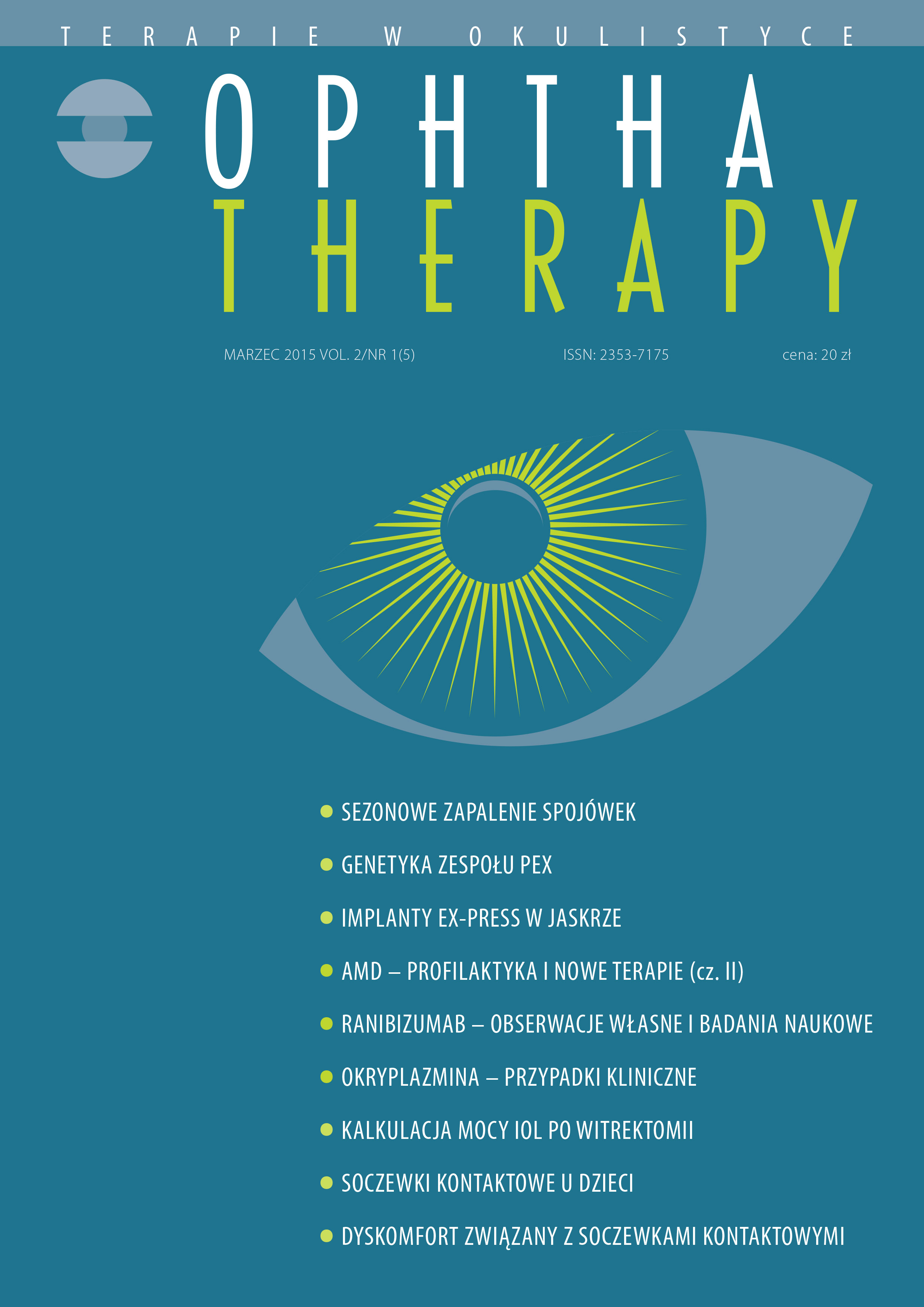Implanty przetokowe typu Ex-PRESS w zaawansowanych postaciach jaskry – doniesienie wstępne
##plugins.themes.bootstrap3.article.main##
Abstrakt
Cel: Ocena skuteczności implantów drenujących typu Ex-PRESS w zaawansowanych postaciach jaskry pierwotnej i wtórnej.
Materiały i metody: Wykonano 38 wszczepów zastawki Ex-PRESS typu P-50 pod płatek twardówki bez miejscowego zastosowania antymetabolitów. Pacjentów poddano czteromiesięcznej obserwacji po zabiegu. Porównano wartości ciśnienia wewnątrzgałkowego (CWG) i ostrość wzroku. Oceniono stan miejscowy po wszczepieniu implantu oraz subiektywne odczucie zmniejszenia bólu w oczach z jaskrą dokonaną i prawie dokonaną.
Wyniki: W badanej grupie pacjentów uzyskano znaczny spadek wartości CWG w pierwszym tygodniu po zabiegu. W grupie pacjentów z jaskrą wtórną pozapalną oraz jaskrą neowaskularną w czteromiesięcznej obserwacji uzyskano ciśnienie zbliżone do wartości sprzed zabiegu. Lepszy efekt hipotensyjny zaobserwowano w grupie pacjentów obciążonych jaskrą pierwotną oraz pourazową. Po wszczepieniu implantu zastawkowego Ex-PRESS odnotowano poprawę ostrości wzroku u większości obserwowanych chorych. Dolegliwości bólowe związane z CWG u pacjentów z jaskrą dokonaną ustąpiły po zabiegu u 6 z 8 pacjentów mających objawy przed zabiegiem.
Wnioski: Implanty zastawkowe typu Ex-PRESS znajdują zastosowanie w leczeniu jaskry zaawansowanej. Obniżają ciśnienie śródgałkowe w krótkoterminowej obserwacji, wpływają na poprawę ostrości wzroku oraz zmniejszają objawy bólowe u pacjentów kwalifikowanych do zabiegu enukleacji. Efektywność zastawki maleje z czasem, jaki upłynął od zabiegu. W dłuższej obserwacji pacjenci wymagają intensyfikacji miejscowego leczenia farmakologicznego. Lepsze efekty uzyskano w jaskrze pierwotnej oraz pourazowej. Zwiększone ryzyko powikłań śród- i pooperacyjnych oraz mniejszą skuteczność zabiegu odnotowano wśród pacjentów z jaskrą pozapalną oraz neowaskularną. Dalsze, długoterminowe badania większych grup pacjentów są niezbędne do oceny skuteczności i bezpieczeństwa stosowania mikroprzetoki Ex-PRESS w zaawansowanych postaciach jaskry.
Pobrania
##plugins.themes.bootstrap3.article.details##

Utwór dostępny jest na licencji Creative Commons Uznanie autorstwa – Użycie niekomercyjne – Bez utworów zależnych 4.0 Międzynarodowe.
Copyright: © Medical Education sp. z o.o. License allowing third parties to copy and redistribute the material in any medium or format and to remix, transform, and build upon the material, provided the original work is properly cited and states its license.
Address reprint requests to: Medical Education, Marcin Kuźma (marcin.kuzma@mededu.pl)
Bibliografia
2. Seibold LK, Rorrer RA, Kahook MY. MRI of the Ex-PRESS stainless steel glaucoma drainage device. Br J Ophthalmol. 2011; 95: 251-4.
3. de Jong LA, Lafuma A, Aguade AS et al. Five-year extension of a clinical trial comparing the Ex-PRESS glaucoma filtration device and trabeculectomy in primary open-angle glaucoma. Clin Ophthalmol. 2011; 5: 527-33.
4. de Jong LA. The Ex-PRESS glaucoma shunt versus trabeculectomy in open-angle glaucoma: a prospective randomized study. Adv Ther. 2009; 26: 336-45.
5. Good TJ, Kahook MY. Assesment of bleb morphologic features and postoperative outcomes after Ex-PRESS Drainage Device implantation versus trabeculectomy. Am J Ophthalmol. 2011; 151(3): 507-13.
6. Minckler D, Baerveldt G, Ramirez MA et al. Clinical results with the trabectome, a novel surgical device for treatment of open-angle glaucoma. Trans Am Ophthalmol Soc. 2006; 104: 40-50.
7. Kanner EM, Netland PA, Sarkisian SR Jr et al. Ex-PRESS miniature glaucoma device implanted under a scleral flap alone or combinated with phacoemulsification cataract surgery. J Glaucoma. 2009; 18: 488-91.
8. Traverso CE, De Feo F, Messas-Kaplan A et al. Long term effect on IOP of a stainless stell glaucoma drainage implant (Ex-PRESS) in combined surgery with phacoemulsification. Br J Ophthalmol. 2005; 89: 425-9.
9. Mermoud A. Ex-PRESS implant. Br J Ophthalmol. 2005; 89: 396-7.
10. Geffen N, Trope GE, Alasbali T et al. Is the Ex-PRESS glaucoma shunt magnetic rezonance imaging safe? J Glaucoma. 2010; 19: 116-8.
11. Sarkisian SR. The Ex-PRESS Mini Glaucoma Shunt: Technique and Experience. Middle East Afr J Ophthalmol. 2009; 16: 134-7

